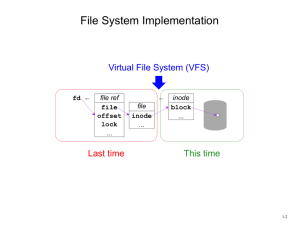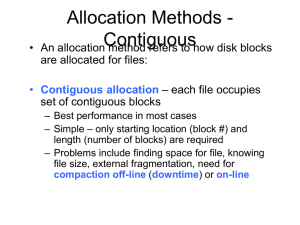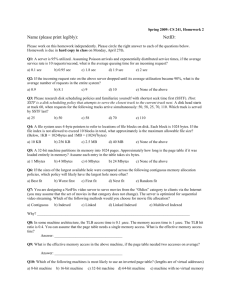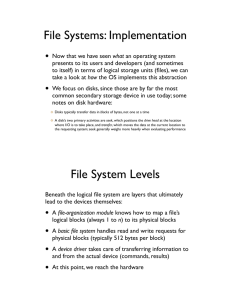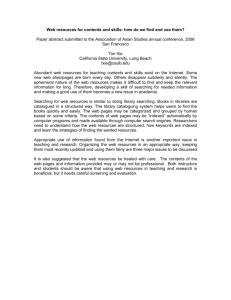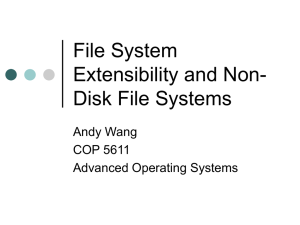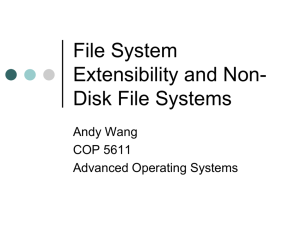File System Implementation
advertisement
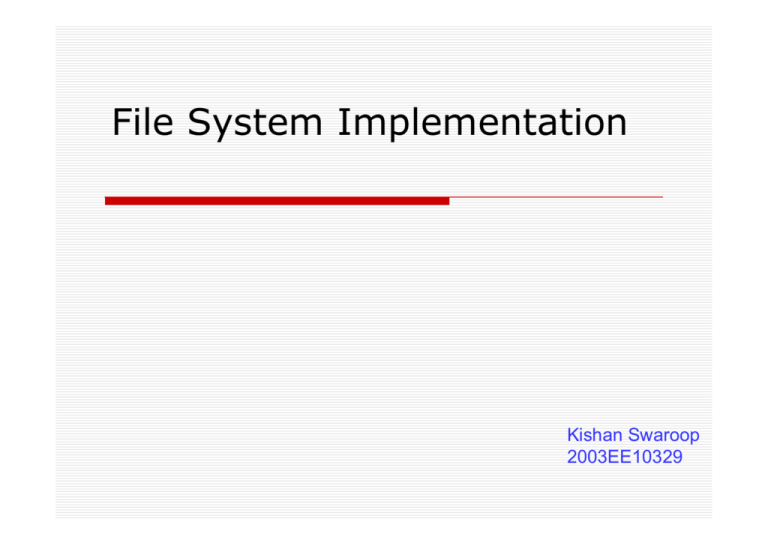
File System Implementation Kishan Swaroop 2003EE10329 OVERVIEW File-System Structure File-System Implementation Allocation Methods ¾ ¾ ¾ Contiguous allocation Linked allocation Indexed allocation File-System Structure File structure Logical storage unit Collection of related information File system resides on secondary storage (disks) File system organized into layers File control block – storage structure consisting of information about a file A Typical File Control Block Layered File System Basic File System Issue generic commands to read and write PB PB is identified by its numeric disk address Basic File System Layered File System File-organization Module knows about files and their logical and PB File-organization module Translate LBA to PB addresses for the basic file system to transfer. Includes the free-space manager which tracks unallocated blocks Layered File System Logical File System (LFS) LFS manage metadata information. directory structure to provide the file organization module file structure via file-control blocks (FCB). Responsible for protection and security Logical File System In-Memory File System Structures in-memory mount table Contains information about each mounted volume. in-memory directory-structure cache holds directory information of recently accessed directories. system-wide open-file table contains copy of the FCB of each open file, as well as other information. per-process open-file table contains pointer to the appropriate entry in the system-wide open-file table In-Memory File System Structures Virtual File Systems (VFS) VFS provide an object-oriented way of implementing file systems. VFS allows the same system call interface to be used for different types of FS. The API is to the VFS interface, rather than any specific type of FS Schematic View of Virtual File System Allocation Methods An allocation method refers to how disk blocks are allocated for files: Contiguous allocation Linked allocation Indexed allocation Contiguous Allocation Each file occupies a set of contiguous blocks on the disk Its Simple starting location (block #) length (number of blocks) are required Random access Contiguous Allocation of Disk Space Contiguous Allocation (Cont.) PROBLEMS ? Finding space for a new file. Wasteful of space How much space is needed for a file Files cannot grow Extent-Based Systems Many newer file systems use a modified contiguous allocation scheme Extent-based file systems allocate disk blocks in extents An extent is a contiguous block of disks Extents are allocated for file allocation A file consists of one or more extents. Linked Allocation Each file is a linked list of disk blocks Blocks may be scattered any where on the disk. block = pointer Linked Allocation (Cont.) Simple – need only starting address Free-space management system – no waste of space No random access Mapping File-allocation table (FAT) disk-space allocation used by MS-DOS and OS/2. Linked Allocation (Cont.) Linked Allocation (Cont.) PROBLEMS ? It can be used effectively only for sequential-access files Space required for the pointer Reliability File-Allocation Table Indexed Allocation Brings all pointers together into the index block. Logical view. index table Example of Indexed Allocation Indexed Allocation (Cont.) Need index table Random access Dynamic access without external fragmentation Indexed Allocation (Cont.) Linked scheme Index block is normally one disk block. it can be read and written directly by itself To allow for large files we can link together several index blocks (no limit on size). Indexed Allocation (Cont.) Multilevel index Use a first-level index block a set of second-level index blocks, file blocks To access a block OS uses the first-level index to find a second-level index block then use block to find the desired data block Indexed Allocation (Cont.) Combined Scheme used in the UFS Keep 15 pointers of the index block in the file's mode. First 12 pointers point to direct blocks contain addresses of blocks that contain data of the file. Next 3 pointers point to indirect blocks. -first points to a single indirect block, which is an index block containing no data but the addresses of blocks that do contain data. -second points to a double indirect block which contains the address of a block that contains the addresses of blocks that contain pointers to the actual data blocks. -last pointer contains the address of a triple indirect block. Combined Scheme:UNIX(4K bytes per block) Chapter 11 Operation System Principles A.Silberschatz 7th edition Thank YOU
